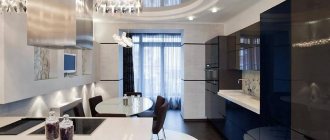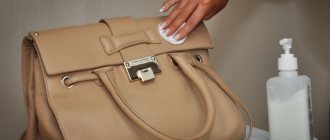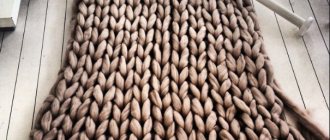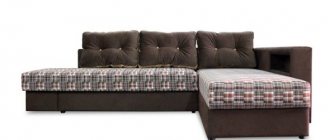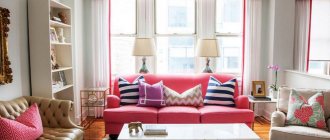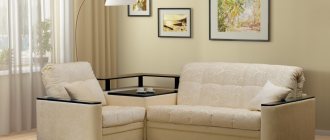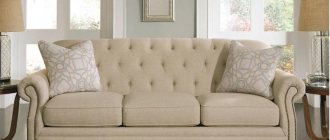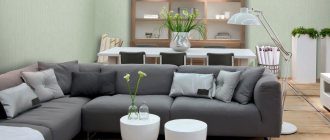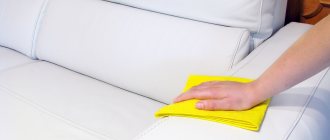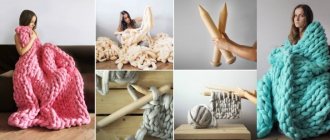Upholstered furniture can be called the central element of any home interior. Usually it is installed in the living room or recreation area. A soft, beautiful sofa can qualitatively decorate the design of a room and make the home more comfortable. Initially, sofas were used exclusively in their “original” form. However, in practice, the owners often had to deal with problems - the upholstery was often torn, worn out, and lost color. In such a situation, it was necessary to do a complete re-upholstery, and this is not a cheap “pleasure”. To avoid such troubles, special capes began to be used in the design of upholstered furniture. They have become an integral part of the decor - just like curtains. This article discusses the features of choosing a high-quality, stylish sofa cover.
A decorative blanket for a sofa will help update the interior or fit an unmatched sofa into the living room.
Why do you need a blanket for the sofa?
It’s nice when, when returning home, the owner of the apartment is greeted with coziness and comfort. This can be provided by some interior details. A sofa cover can perform the following functions:
- Updating furniture. If scuffs have formed on the armrests, back and seats of the furniture interior, it has lost its original appearance, and there is no money to buy a new one, then you can cover these disheveled areas with a beautiful blanket for upholstered furniture.
- The ability to protect expensive upholstery from mechanical damage. When you buy new furniture items, you can protect them from the claws of pets or the pranks of small children.
- During the cold season, you can make a leather couch softer and warmer. If you choose a fur blanket for the sofa, then it will warm you up when the room is cool.
- Change the design of the room. If you are tired of the old furnishings and want to change it to a new, modern one, recognized by designers, then you can start with a blanket for the sofa and armchairs. Currently, you can choose an option to suit any style and design.
This accessory performs a protective function, protects the sofa upholstery from rapid contamination, mechanical stress, dust, hair from cats or dogs, thereby helping it maintain its original appearance and extend its service life, and also allows you to hide problem areas of the upholstery.
How to choose the perfect blanket?
A sofa blanket is a multifunctional item and is often used for everyday needs, so it is important not just to choose a visually attractive option in the store, but to take care of the usefulness of the new purchase.
Firstly, when using a sofa with a blanket in the interior, it is important to consider that such a household item primarily serves as a blanket, so the blanket should be warm and as comfortable as possible.
Secondly, the significant factor is not soiling. For the same reason, you need to choose blankets that match the size of the sofa so that the hanging edges do not get dirty.
Remember that even on blankets that serve as bedspreads, guests will definitely sit, children or animals will play. It’s worth finding out in advance which material is right for you, because modern blankets are made from a huge amount of different raw materials.
Thirdly, the product must be of high quality, made of good material. Pay attention to seams, folds, and loose loops. Aesthetic appeal is an important factor, because a blanket should decorate the interior.
Of course, when you come to the store, you should already know what you want to buy so that your eyes don’t run wild from the variety of options. To do this, find photos of sofa blankets on the Internet and imagine how the models you like will fit into the design of your living room.
Types of bedspreads
This type of coverage may differ in the following indicators:
- Shape and size.
- Appearance.
- Material.
- Additional accessories.
- Densities.
The decorative design of the blanket should create a harmonious combination with other interior elements, such as curtains, pillows or rugs.
You can choose a bedspread for a corner sofa, for a straight one, ottomans, armchairs. To do this, you will need to measure the furniture parts and select suitable options in the store. It is worth paying attention to some of the improvements that the textile industry offers.
For a leather sofa, soft blankets that retain heat well are suitable. To prevent the cape from slipping off this upholstery, you should consider ways to attach it or choose non-slip models made of cotton or bamboo.
For example, you can choose a bedspread for a corner sofa bed with frills or interesting prints. Also, to ensure that this cape does not slip and remains in place, there are options with elastic bands, rivets, and Velcro. This item is easy to remove and wash.
A large number of covers, which can be classic and simple fabrics or models with additional functionality, can become a decoration for any type of sofa structure, for example, corner, straight, island or Eurobook.
The fabric for a sofa bedspread may vary in texture. There are various offers for this part of the interior from fleece, fur, wool, cotton, bamboo, linen, polyester, viscose, velor. Density may also vary. If children and animals live in the apartment, then you should choose a dense fabric texture that is resistant to damage.
The styles of these products completely depend on the upholstered furniture and the location on it. These can be simple models or one-piece and composite covers.
Upholstery and blanket color: harmonious combinations
When choosing textiles for your furniture, remember the importance of color combinations: shades that are not in harmony with each other or contradict the chosen interior style will create an imbalance in the overall design of the room. How to choose the right cover for your sofa depending on its color?
Contrasting combination of plaid and sofa upholstery
Light upholstery
White color will make an excellent pair with any shade and print, so you need to choose textiles for such a sofa primarily based on the style of the room. For modern, laconic interior styles (minimalism and loft, for example), models in dark shades (gray, deep blue, emerald, burgundy, brown) as well as checkered ones in the same tones are suitable. In the Scandinavian style, dusty colors and chunky knits look impressive, as do fabrics with geometric prints.
Dark gray plaid on a light sofa in a minimalist style
Textured gray blanket for a white sofa
Checkered plaid on a light gray sofa
Checkered plaid for a white sofa in a Scandinavian style
Powder blanket on a light sofa in Scandinavian style
Models with bright patterns are also suitable for the boho style: in this case, choose animalistic, floral and ethnic motifs. Animal art will also perfectly complement a white sofa in a classic interior style or art deco, but the options are in neutral colors. (gray, beige) would also be appropriate here.
Blanket with an ethnic pattern for a white sofa in boho style
Animalistic plaid on a white sofa in a classic style
Monochrome ethnic plaid for a white sofa
A bright plaid - yellow, red, green, blue - will harmoniously complement a modern interior, pop art style or the same boho (especially if the model is decorated with fringe or tassels). Colorful options look perfect in a children's room.
Bright plaid on a light sofa in boho style
Blue plaid on a light sofa in a modern interior style
Bright plaid on a white sofa in the nursery
Delicate pastel shades (sky blue and powder pink are good in the Provence and romantic style, but can also be used in a classic interior). Such textiles will perfectly complement light furniture in a girl’s nursery.
Powdery blanket on a beige sofa in a romantic interior style
Pastel pink plaid on a white sofa
Pink plaid on a light sofa in a girl's nursery
Dark gamma
Graphite gray, black, dark brown furniture is an attribute of classic and Scandinavian style, minimalism and loft. A dark sofa covered with a white or beige blanket of an interesting texture (for example, voluminous knitted or fur) looks beautiful. Such upholstery will also make a successful combination with a large checkered pattern in classic shades - red, blue and green.
Light plaid on a sofa with black upholstery
White textured knit blanket for a dark sofa
Light fur blanket for a dark brown sofa in loft style
Beige plaid on a dark brown sofa in a classic interior
Red checkered blanket for a dark gray sofa
Of the bright colors for gray and black sofas, red, yellow, blue and pink are best suited. Brown upholstery harmonizes perfectly with shades of indigo and turquoise.
Bright yellow throw for sofa with dark gray upholstery
Pink blanket for a black leather sofa
Turquoise blanket on a sofa with dark brown upholstery
Pastel shades
All pastel shades go well with each other: a sky blue blanket goes well with powder furniture, pink or lemon with blue, lilac or mint with lemon, and so on. If you're looking for a neutral option, go for white or beige textiles.
Pastel yellow throw for a blue sofa
Pastel green plaid on a light yellow sofa
Light beige blanket for a pastel pink sofa
Another wonderful and more complex option is a plaid in a rich variation of the upholstery shade: hot pink + powder, dark blue + light blue, and the like.
Soft blue blanket for a pastel blue sofa
You should not choose black throws for pastel sofas: they look too rough in combination with washed-out colors. If you still want dark textiles, opt for gray tones.
Dark gray plaid for a pink sofa in a Scandinavian style
Bright sofa
When choosing a blanket for a sofa with bright upholstery, pay attention to neutral shades - white, beige, gray, black. To create effective contrast, combine complementary colors: green and red, blue and yellow, purple and orange.
Neutral gray plaid on a bright yellow sofa
A blanket in a milky shade for an emerald green sofa
Beige plaid for a bright red sofa in the living room
Contrasting blue blanket for a yellow sofa
The combination of complementary purple and yellow colors of the sofa and blanket
The most interesting combination will be obtained if you choose textiles with a print, one of the shades of which matches the color of the upholstery. It can be any design - geometric, floral, animalistic: it all depends on your preferences. A monochrome black and white bedspread will match any color of furniture.
Plaid with red print to match the color of the sofa
Printed monochrome throw for a bright green sofa
How does a bedspread differ from a cape?
When the time comes to purchase, then many do not know the difference between a cape and a sofa bedspread. They differ in fabric, size, and purpose. For a guest sofa, it is better to choose a blanket. It is denser, wear-resistant, and has a special design and prints. A cape can beautifully decorate a bed and serve as a blanket.
Some capes are suitable for decorating not only folded, but also unfolded furniture structures.
Conclusion
To summarize, it is worth saying that size is the main criterion for choosing bedspreads. If you can rely on your own taste when choosing the type of fabric, then the size of the bedspread directly depends on the dimensions of the bed. Therefore, the choice of material should begin only after the buyer has decided on the size of the product.
When determining the appropriate size, you should measure not only the length and width of the bed, but also its height. The ideal option would be bedspreads that cover the legs and sides of furniture. But at the same time they should be at a distance of 1-2 cm from the floor. When choosing a bedspread, other factors should be taken into account: material of manufacture, color, design, texture, presence of decorative elements and cost.
Design features and shape of the bedspread
Covers for corner sofas have their own peculiarity. They differ from the usual options for standard furniture. In order to cover the entire surface, you need to carefully select a bedspread or order it from a studio where they can make it according to individual measurements. It takes into account which side the turn will be made at an angle.
The choice of material is the main factor that determines the service life of the product and the comfort of the interior.
In addition, a cover for a corner sofa can consist of several separate parts and cover only its parts: the back, seat, armrests. You can also choose a blanket for a corner sofa with elastic bands made of a material with stretch capabilities. This will allow you to place it over the entire surface and prevent it from slipping.
Products made from tapestry and velor are durable, easy to wash and do not slip.
A blanket for a sofa with armrests should completely follow the shape of this interior detail. To do this, you need to know the name of the model, its dimensions, and special design characteristics.
Important! It is necessary to take into account the existing design in the room. If it is classic, then you should avoid prints, bright applications and opt for restrained shades. If you want to make bright accents, then the cover on the sofa should be several tones brighter than the overall design of the walls and interior details. For the Provence style, you can choose fabric with small patterns and flowers.
Covers can be placed separately on the back, only on the seat, or completely cover the entire piece of furniture along with the armrests.
How to decorate a sofa with a blanket
To beautifully cover your sofa with a blanket, just choose one of these methods! Focus on your needs and ideas about the overall design of the room.
Accent double-sided blanket for sofa decor
1. Blanket for the seat. The most popular and easiest way to put a blanket on a sofa is to carefully cover the seat with it. Together with it, you can also cover the back of your furniture: if you unfold the structure to accommodate a large group, the upholstery will be completely covered. The principle here is the same as when decorating a bed: only the armrests, like the headboards of the bed, remain open.
Plaid blanket on the seat and back of the sofa
Fur blanket on the sofa seat
2. Closed armrests. If for some reason you are not satisfied with the appearance of the sofa, for example, it no longer fits into the style of the interior, cover it entirely with a blanket, covering even the armrests. With the help of textiles, you can easily give the furniture an appearance that matches the color scheme and design of the entire room. By taking another blanket, you can at any time give the room a bright accent with color or print, or a seasonal mood - for example, New Year's or holiday.
Decorative blanket cover for the entire sofa with armrests
Blanket cover for the entire sofa with a marine print
Remember: if your sofa is in the center of the room, the cover should also cover the back of the back so that this piece of furniture has a unified style.
Large blanket cover over the entire surface of the sofa
3. Corner design. There are two ways to cover a corner sofa: with one blanket or two. In the case of one cover, simply cover half of the sofa, ideally using method No. 1 (covering the seat with a back or just the seat). If you want to cover the entire furniture, take two blankets, one for each half. They don't have to be the same: you can take models in different shades or plain and printed, but try to stick to the same style - similar materials and complementary colors.
Decorating a corner sofa with one blanket
Decorating a corner sofa with two identical blankets
4. Decor. A blanket can serve a purely decorative function: to do this, take a small model and simply casually lay it on the sofa. Carelessness is the key concept: do not strive for perfect symmetry and an even surface without wrinkles. However, do not confuse it with sloppiness - a shapeless lump of fabric on your furniture will not add beauty to the room. Hang the textiles on the back or armrest, lay them out on the seat, allowing the corner to hang down a little... Use your imagination! And for inspiration, see the photo below.
Decorative blanket carelessly thrown on the sofa
Plaid on the armrest of the sofa to match the upholstery
Rules for choosing a bedspread for a sofa
The color scheme of the chosen version of the stylish bedspread for the sofa is also important. This element should not merge with the overall interior. It can serve as decoration and add bright accents, emphasizing the design of the walls.
If the sofa is located in the center of the room, its back should also be protected by a cover.
If the room is small, then you should pay attention to light shades of bedspreads. They will visually make the room larger. For a living room that faces south, you need to pay attention to things in cool colors:
- blue;
- light green;
- green;
- lilac;
- blue.
There are a huge variety of color solutions for this textile, for example, products can be green, light green, turquoise, orange, yellow, burgundy, blue, black, violet, beige, blue, gray, white, or even have a two-color design with a combination of different colors.
For those rooms that have access to the north side and are rarely filled with light, it is worth choosing a cape in warm colors: light yellow, pink, red, orange.
To the bedroom
This is a place to relax and sleep. It is always decorated in subdued colors that lead to relaxation, create comfort and coziness. It is best to cover a bed or folding sofa with a soft and pleasant-to-touch blanket. You can choose a sofa cover made of faux fur. It will create a feeling of comfort and invite you to touch it. In addition, this material is practical, durable, and will fit most designs.
Advice. Choose a bedspread that is light in color. This will make the room illuminated with natural colors. In addition, such a cape can suit any interior, both classic and modern.
It is not advisable for the blanket to have a shade that is not repeated in the surrounding interior space or matches the color of the upholstered furniture; this will deprive the blanket of its individuality.
To the children's room
A sofa bedspread for a child should be bright, with designs that are interesting to him. For example, for a boy, you can choose a purple or blue covering for furniture with images of cartoon characters, a nautical theme, or with cars. For girls, you need a delicate and soft bedspread in light shades. You can choose pink with a picture of a princess or beautiful flowers and butterflies.
Textiles for a sofa or sofa for a child should be particularly practical, natural and not cause allergies.
This cape should withstand children's pranks. You should choose a dense material that does not wrinkle and is resistant to mechanical damage. If the child is small in age, then it is better to choose a non-staining blanket.
In a girl's nursery, capes in warmer peach, pink, and beige tones would be appropriate.
To the living room
This room is the “face” of its owner and should reflect his character and sense of taste. Criterias of choice:
- Select according to the design of the room.
- Keep in mind that the size of this product should completely cover the sofa or sofa and just go beyond the back of this furniture. This will allow it not to slide when people sitting on it move.
- Easy-to-care fabric is easier to wash, dry, and iron.
- When the cover rubs against the upholstery of the armrests and seat, static electricity may be generated. It is best to give preference to natural materials.
- Silk and satin fabrics can constantly slip.
- You need to choose the same cover for both the sofa and the chair.
The choice of a cape in the living room primarily depends on its style. Often here they use textiles decorated with a simple print and complement it with the same type of pillow covers or use fluffy and fleecy models that are particularly soft.
To the kitchen
A cover for a sofa in the kitchen can make this room cozy and stylishly decorated. In addition, the fabric should be easy to care for and can be washed quickly if it gets stained with grease. Do not forget that this room is intended for cooking and splashes may not be avoided during this process. You can choose fleece, bamboo, cotton, velor.
The sofa can be placed behind a partition or bar counter.
Materials for the blanket
Let's take a closer look at the popular materials from which blankets are made.
Acrylic
A synthetic material made from natural gas.
Material Features:
- wear resistance;
- thermoregulation;
- ease;
- unpretentious care (can be washed in a washing machine);
- does not cause allergies;
- affordable price;
- aesthetic appearance, imitation of natural wool.
Blankets are made both from pure acrylic and with the addition of cotton - such a product allows air to pass through better and is more pleasant to the touch. Over time, pellets form on the material, which must be removed manually. Acrylic absorbs odors well, so it is not suitable for the kitchen.
Camel's wool
Products made from natural wool are not cheap.
Natural material, one of the best of its kind. Products made from natural camel wool are expensive because the raw material is produced in limited quantities.
Material properties:
- softness;
- lightness (camel wool is lighter than sheep wool);
- heat preservation;
- hygroscopicity;
- hypoallergenic;
- breathability;
- wear resistance.
Wool does not dye well, so there are only natural colors in beige and brown tones.
Viscose
An artificial material that is obtained by chemically processing natural raw materials - cellulose.
Advantages of viscose:
- the material is pleasant to the touch;
- does not accumulate static electricity;
- retains color perfectly, suitable for creating bright blankets;
- lightness and strength;
- safety and hygiene.
Viscose is affordable and lightweight soft blankets are made from it. Unfortunately, the material wrinkles, so the products should be protected from creases. When wet, viscose fibers become brittle and less resistant to tearing.
Jacquard
The jacquard blanket can be double-sided.
Jacquard blankets are made from various materials - cotton, linen, wool, synthetics. The main feature of the material is its large woven pattern.
Peculiarities:
- high wear resistance;
- jacquard blanket can be washed;
- aesthetic appearance;
- heat preservation.
The jacquard pattern can be different - one-sided and double-sided, with pile, small and large.
Artificial fur
A wonderful humane material, in the creation of which not a single living creature suffers. The finished pile is glued onto a woven base and thermally bonded. Most often, faux fur is made from synthetic materials.
Properties:
- strength, durability;
- hygroscopicity;
- unique appearance;
- ease of care;
- heat preservation.
Fur blankets are produced in various colors - plain, with a pattern, with imitation of real fur. Products attract dust, so they need to be vacuumed from time to time.
Cashmere and pashmina
Blankets made from these materials are very soft and delicate to the touch, but their price is quite high. Cashmere is called the down of a mountain goat; its fibers are extremely thin and durable. The word "pashmina" comes from the Persian word for "wool" - this is also a material made from goat fluff, but of a higher quality.
Characteristics of cashmere:
- subtlety and lightness;
- strength and durability;
- softness and tenderness;
- does not cause itching or allergies.
This blanket is very demanding to care for and can only be washed by hand, but it looks very good and decorates any interior.
Microfiber
A synthetic, wrinkle-resistant material made from polymer threads (polyester, nylon). Microfiber consists of very fine fibers, which provides the blanket with extreme softness.
Advantages of the material:
- does not deform;
- strength, wear resistance, durability;
- absorbs moisture well;
- allows air to pass through.
Microfiber blankets should be protected from exposure to high temperatures to avoid damaging the fibers.
Sheep's wool
Excellent natural material, warms very well and absorbs moisture. Sheep wool is affordable and also has a healing effect on the body.
Natural wool blanket:
- allows air to pass through;
- self-cleaning;
- does not accumulate static electricity.
Low quality products may prick. Wool is difficult to dye, so it is best to purchase blankets in natural shades.
Plush
The disadvantage of a plush blanket is the rapid accumulation of dust.
A plush blanket is a fabric with a high, smooth pile. Externally, the material resembles soft shiny wool, and sometimes terry; it is dyed in various colors. Plush is made from wool and cotton, as well as viscose.
Material Features:
- beauty;
- strength;
- heat preservation;
- dimensional stability;
- color fastness.
Plush made from natural materials is more expensive than synthetic ones. It accumulates dust and is wiped off if not properly cared for. It is difficult to remove stains from a plush blanket, so it is not suitable for a child's room or kitchen.
Polyester
Synthetic polyester fabric created in the last century. The material does not wrinkle, dries quickly and does not require complex care. Other advantages include:
- variety of texture and design;
- wear resistance;
- ease;
- affordable price.
Often blankets are not made from pure polyester, but polyamide, spandex, cotton, viscose and natural wool are also added.
Fleece
Fully synthetic knitted fabric, a type of polyester. Features of a fleece blanket:
- the products are very light;
- breathability;
- elasticity;
- the material dries quickly;
- keeps warm.
Fleece must be protected from exposure to high temperatures, as the material becomes electrified. From time to time the blanket needs to be vacuumed and shaken to prevent dust from accumulating.
Cotton
A cotton blanket is practical and durable.
Natural plant material, very pleasant to the body. A large number of different fabrics are made from cotton, as well as with its participation, including rugs.
Positive aspects of the material:
- hygroscopicity;
- breathability;
- durability and practicality;
- does not cause allergies;
- paints well.
Cotton will perfectly protect the sofa from dust and also warm you on cold evenings.
How to make a blanket for a sofa with your own hands
You can develop the design of bedspreads for upholstered furniture on your own. First you need to measure the sofa part and all its elements. Select material. It must be larger than the size of the finished product. This will allow you to make seams and not reduce the size of the product. If you want to sew a fur blanket, then it is better to choose faux fur. It is easier to process and stitch.
Knitted blankets are unusual: you won’t find them in every home; they can often be called masterpieces of design art.
The design solution allows you to make a cape from multi-colored pieces. This will add authenticity to the room and add personality to it. To do this you need to select many different pieces. It is desirable that they all be made of the same material or fabric with a similar structure. Having laid them out on the floor, you need to trim the edges and create a visual model of the required size. After this, you can sew them by hand or on a sewing machine. If necessary, the seams can be treated with a special seam, which will prevent them from fraying.
Decorative tassels will decorate your blanket.
Advice. You need to choose a type of fabric that can be processed better. If you do not have great sewing skills, it is better to entrust this matter to professionals and take the order to a specialized studio. Then you don’t have to worry that the fabric will be damaged by poor cutting and sewing.
Contact a professional for help sewing your bedspread.
How to care for a bedspread?
Caring for a blanket depends on the material from which it is made. Here are some tips to help extend the life of your product.
- Before washing, you should always study the rules on the label. An error may result in tissue damage.
- It is not recommended to soak colored capes. This will lead to a change in the original shade - it will become paler. If you need to remove stains or dirt, it is better to have such a product dry cleaned.
- Fur bedspreads should not be washed by yourself. A mistake can lead to hair simply falling out. The only cleaning method is dry cleaning services.
- Dry the bedspreads naturally. To do this, they are hung on a clothesline located in the open air. However, do not expose the cape to direct sunlight - it may fade.
- It is better to wash synthetic and natural fabrics separately. Synthetics can harm materials such as cotton, linen, and wool.
washing machine
How to beautifully put a blanket, cape or blanket on the sofa
It is not necessary to use traditional methods of covering furniture. You can place it completely, covering the entire surface of the sofa, or place it only on the seat or back.
A plaid can complement upholstered furniture in any interior style, be it Provence, country, classic, maritime, Scandinavian, boho, ethno-style or others.
Designers offer a new solution that helps place the cape in an unusual way. This is to put it at an angle. If the sofa is corner, then you need to use either two bedspreads or a custom-made cover. If the cape also serves as a blanket or is purely aesthetic, then you can casually lay it on the back and lightly fill the seat with fabric.
In a classic interior, carpets or tapestry, velvet, thin satin, silk bedspreads, embroidered with golden threads or decorated with luxurious ornaments are appropriate.
How to cover an old and worn out sofa
It often happens that the sofa is already old, so its appearance leaves much to be desired. Dirt and even holes don't look very nice, but a bedspread can transform even an old sofa.
To do this, you can use a special elastic cover. Thanks to this product, the furniture will look beautiful again. If desired, you can lay a blanket on top of such a cover.
It is very important to choose high-quality textiles so that the bedspread does not roll, wrinkle, or slide off the seat.
Advantages and disadvantages
A blanket for a sofa has its advantages and disadvantages. It is worth considering the main ones. Advantages:
- You can update the furniture and make it brighter.
- It is possible to change the bedspread in accordance with the new renovation.
- New furniture does not deteriorate or become dirty.
- A faux fur sofa cover will help create coziness and make the room stylish.
- If the material becomes dirty, it can be washed in a washing machine in accordance with the care instructions on the product label.
- You can make the room brighter if you choose the optimal shades.
A blanket for a sofa is a real interior find and a very stylish and elegant decorative element that allows you to harmonize and decorate the surrounding space.
Flaws:
- Discoloration. If this product is exposed to direct sunlight, it may lose its color.
- Wearability. If this decorative item is often impacted, then it can become deformed, stretched, and lose its original appearance.
- Shrinkage. When washed, natural fabric may shrink and become smaller in size.
- Wrinkleability. Some material may wrinkle.
This product has a front and back side, which can equally be used as decoration.
If you choose the right cape or bedspread, you can beautifully decorate a room, create unusual elements in it, or make it much more comfortable. By following the suggested selection criteria, you can choose the best product for yourself.
Color solution
The choice of color for a bedspread is one of the most important points, since with the help of a large spot of color you can transform or ruin the interior.
There are several principles for selecting a bedspread for the living room:
- Matches the main color in the interior. The bedspread, in this case, can be a tone darker than the main color or a tone lighter. But it should be lighter than the floor covering; this will correctly structure the space.
- Match the color of the curtains. In this case, the tone of the bedspread should match the color of the curtains, but the texture should be different. You should not make these items from the same fabric, otherwise it will seem like someone laid curtains on the sofa or hung a blanket on the window.
- In contrast to the color of walls, curtains or the main tone of the room. Contrast is appropriate if the primary colors are neutral: gray, white or brown and occupy large surfaces. The bedspread can be in bright colors: red, electric, tiffany, pistachio. It should be noted that there can be 1-2 bright accents in the room, no more. Therefore, a bright blanket here will be the center of the composition.
You can choose several bedspreads in different colors, then you can change not only the interior, but also its mood. And this will definitely please your family.
Photo gallery: examples of sofa design with different types of bedspreads
General tips for choosing fabric for a bedspread
If you are going to sew a bedspread yourself, choose the fabric very responsibly. Listen to the following tips:
- Don't be fooled by the low price. Dumping is often carried out by unscrupulous manufacturers. After just 1-2 washes, cheap fabric can fade or stretch.
- If you want to make a durable bedspread, buy a material with a combination of natural and synthetic fibers.
- Avoid fabrics that give off an unpleasant chemical smell.
- If you are going to sew a bedspread for your bedroom bed, give preference to fabrics in pastel or warm colors. The former calm the psyche, and the latter give a feeling of comfort.
Sometimes fabric allows you to correct visual flaws in the interior. For example, vertical stripes make the room more proportional, and a light glossy surface increases the space.
